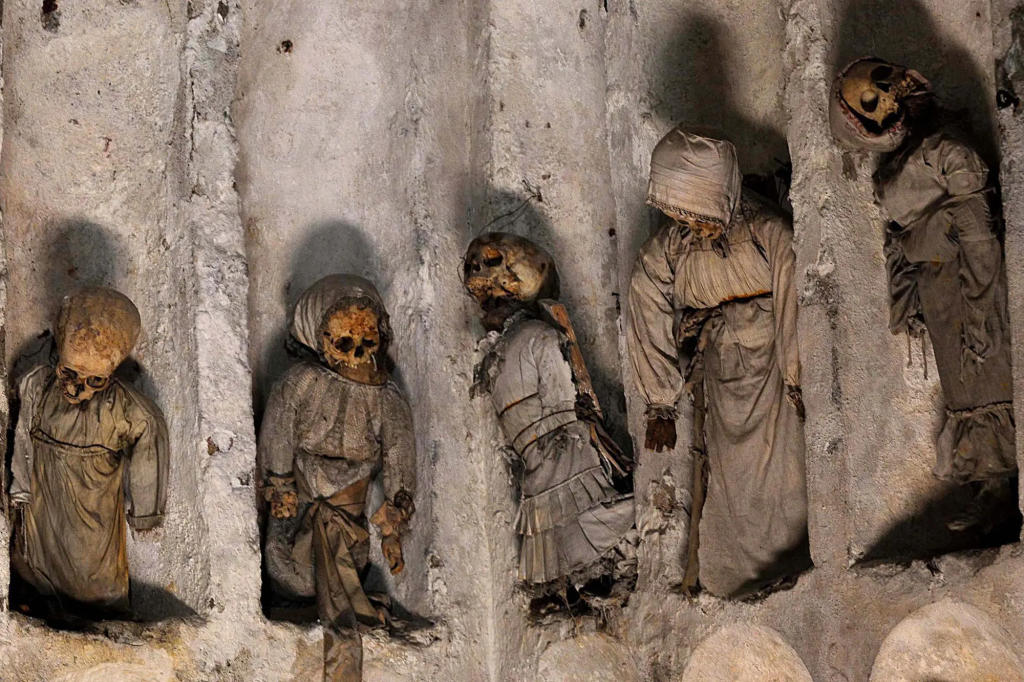Deep within the haunting Capuchin Catacombs of Palermo in northern Sicily lies an enduring mystery surrounding the lives and untimely deaths of mummified children. Researchers from Staffordshire University in England have undertaken a meticulous investigation to unlock the secrets behind these preserved remains, focusing on uncovering the narratives of a time long past.
At the heart of this enigmatic endeavor is the “Children’s Room,” a section of the catacombs containing 41 juvenile mummies. Although the catacombs house an estimated 163 child mummies scattered across their sacred confines, the team has zeroed in on this specific group for detailed examination. One particular child mummy, put on display on January 31, 2011, has become a focal point of the research and symbolizes the broader effort to delve into the stories of these children.

Dr. Kirsty Squires, the principal investigator of this project, is leading a team employing cutting-edge, non-invasive X-ray technology to examine the juvenile remains. Historically, research on the Capuchin Catacombs has concentrated largely on adult mummies, neglecting the narratives of the younger individuals interred there. This study marks a significant shift in focus, aiming to reconstruct the identities, lives, and circumstances of death for these children while exploring the reasons behind their placement in this sacred resting place.
The project is firmly rooted in a framework of ethical responsibility. Given the sensitive nature of studying human remains, particularly those of children, Dr. Squires and her team are collaborating closely with the Capuchin friars, custodians of the catacombs. Together, they are ensuring that the research adheres to ethical guidelines and respectful practices. One critical decision made by the team was to avoid invasive methods, such as autopsies, to minimize disruption to the remains. Instead, they opted for X-ray technology, which allows for detailed internal examination without compromising the physical integrity of the mummies.
Maintaining the dignity of the deceased has been a paramount concern throughout the research process. To honor this principle, the team has refrained from sharing photographs of the mummified children on social media or other public platforms. Instead, these images are reserved exclusively for academic purposes, ensuring that they are handled with the utmost care and respect. To bridge the gap between scientific inquiry and public interest, the researchers partnered with artist Eduardo Hernandez to produce illustrations inspired by their findings. These artworks offer a glimpse into the catacombs without exposing the public to potentially distressing images of deceased children, allowing the broader audience to engage with the research in a thoughtful and respectful manner.
The Capuchin Catacombs themselves are steeped in history, dating back to their establishment in 1599. Initially, the site was created to house monks who had been buried and naturally mummified, but over time, it evolved into a burial place for wealthy and influential individuals seeking to showcase their status. By the late 18th and early 19th centuries, the catacombs had become a repository of elite mummies, each adorned in garments that reflected their social standing. Today, the site serves as both a historical landmark and a tourist destination, home to approximately 1,284 mummies, which National Geographic describes as some of the best-preserved in the world.
The decision of the wealthy to place their loved ones, including children, in the catacombs reflects a cultural practice that intertwined death, religion, and societal prestige. For the children, the reasons behind their mummification and placement in this sacred space remain enigmatic. Some may have been honored as a result of their family’s social status, while others might have been preserved due to the parents’ desire to keep their memory alive in a physical form. The research team hopes to uncover more about these motivations, offering new insights into the cultural and historical significance of child mummification in this era.
This groundbreaking investigation also seeks to shed light on the health, diet, and potential causes of death of these children. By examining skeletal structures and dental remains through X-rays, researchers aim to piece together details about their lives, including signs of disease, malnutrition, or other factors that may have contributed to their early demise. In doing so, they hope to reconstruct a broader narrative about childhood and mortality in this historical period.
Beyond the scientific and historical implications, the project has a deeply human dimension. Each child mummy represents an individual life, a unique story cut short. The researchers’ commitment to preserving their dignity ensures that the study is not merely an academic exercise but also a tribute to the lives that were once lived. By unlocking the secrets of the past, the team offers a voice to those who have been silent for centuries, reconnecting us with the humanity of previous generations.
The Capuchin Catacombs continue to fascinate visitors and scholars alike, offering a window into a bygone era where death was both a solemn reality and a cultural statement. As the investigation progresses, it promises to bring new discoveries, enrich our understanding of the past, and deepen our appreciation for the complex interplay between life, death, and memory. These mummified children, once relegated to the shadows of history, now stand at the forefront of an exploration that bridges the ancient and modern worlds, reminding us of the enduring power of human connection across the ages.





